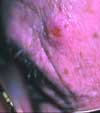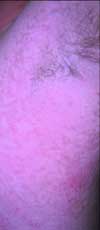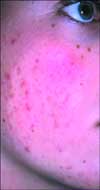- Clinical Technology
- Adult Immunization
- Hepatology
- Pediatric Immunization
- Screening
- Psychiatry
- Allergy
- Women's Health
- Cardiology
- Pediatrics
- Dermatology
- Endocrinology
- Pain Management
- Gastroenterology
- Infectious Disease
- Obesity Medicine
- Rheumatology
- Nephrology
- Neurology
- Pulmonology
Angiolymphoid Hyperplasia With Eosinophilia and Papillomatosis: Confluent and Reticulated
A tender nodule; an itchy truncal rash; multiple pruritic eruptions--can you identify the disorders pictured here?
Case 1:

A 72-year-old man has had a slightly tender nodule on his forehead for 3 weeks. There is no history of trauma or exposure. He has taken the same antihypertensive and cholesterol-lowering agents for years.
What does this look like to you?
A. Insect bite.
B. Staphylococcal folliculitis.
C. Basal cell carcinoma.
D. Angiolymphoid hyperplasia with eosinophilia.
E. Keratoacanthoma.
(Answer on next page.)

Case 1:
A biopsy confirmed the diagnosis of
angiolymphoid hyperplasia with eosinophilia, D.
This uncommon condition presents with painful or pruritic dome-shaped papules or nodules typically on the head and neck, although they can occur elsewhere. The lesions do not regress spontaneously; management options include intralesional corticosteroids, pulsed dye laser treatments, and excision.
Insect bites are typically pruritic and resolve within 2 weeks. Staphylococcal infections are usually more erythematous and more painful. Basal cell carcinoma develops more slowly. Keratoacanthoma may initially look similar, but usually features a keratotic center, which is absent in this patient.
Case 2:

For the past month, a 15-year-old boy has had a slightly pruritic eruption on the chest and sides of the trunk extending to the axillae. He is otherwise healthy and takes no medications.
What is your clinical impression?
A. Tinea versicolor.
B. Confluent and reticulated papillomatosis.
C. Vitiligo.
D. Acanthosis nigricans.
E. Becker nevus.
(Answer on next page.)

Case 2:
This is a classic presentation of
confluent and reticulated papillomatosis, B,
an eruption seen after puberty that begins in the inframammary region and extends to the trunk. The cause is unknown. In most patients, treatment with minocycline or azithromycin is successful.Topical tretinoin and other keratolytic agents are also used.
Tinea versicolor may be ruled out by negative results on a potassium hydroxide evaluation and lack of response to antifungal therapy. Vitiligo is associated with loss of pigment. Acanthosis nigricans is a confluent velvety hyperpigmentation confined to the intertriginous areas of the neck and axillae. Becker nevus is a well-circumscribed area of hyperpigmentation typically seen on the trunk. These nevi develop at puberty and usually feature a patch of hair.

Case 3:
A 16-year-old boy presents for evaluation of an acne outbreak. He had completed a course of isotretinoin treatment 5 months earlier, and his acne had resolved. The patient recently started playing football.
What might explain the current eruption?
A. The high incidence of acne relapse in teenaged boys.
B. External factors, such as the wearing of a football uniform.
C. A new shaving technique.
D. A secondary bacterial infection, such as a staphylococcal infection.
E. Any of the above.
What action would you take?
F.
Start a second course of oral isotretinoin therapy.
G.
Prescribe a broad-spectrum oral antibiotic.
H.
Prescribe a topical antibiotic.
I.
Prescribe a topical retinoid or azelaic acid.
J.
Advise the patient to wash his face several times a day with an antibacterial soap.
K.
Advise the patient to stop playing football for 1 week.
(Answer on next page.)

Case 3:
The patient's
football helmet, B,
precipitated the eruption. However, any of the other factors listed might reasonably explain the outbreak.
At this stage, conventional therapy (any combination of G, H, I, and J) is appropriate; however, it is not always successful. The acne may not clear until the end of the football season, when the occlusion is removed. Isotretinoin is effective, but it would not be considered first-line treatment in this setting.

Case 4:
For 3 weeks, a 46-year-old woman has been bothered by pruritus under the breasts, in the groin, and in the nasolabial area and eyebrows. The eruption in all 3 areas features erythema and minimal scale. The patient has type 2 diabetes that is controlled with an oral hypoglycemic agent. She has recently been under stress.
Which of the following do you suspect?
A. Candidiasis.
B. Seborrheic dermatitis.
C. Contact dermatitis.
D. Dermatophyte infection.
E. Lichen simplex chronicus.
(Answer on next page.)

Case 4:
The distribution is consistent with
seborrheic dermatitis, B,
which can be exacerbated by seasonal changes and stress. The patient's condition responded to a combination of topical antifungal cream and a mild topical corticosteroid cream, used as needed.
Candidiasis is often found under the breasts and in the groin, but it would be highly unusual on the face. A potassium hydroxide (KOH) evaluation would help rule it out. The distribution is highly unlikely for contact dermatitis. A dermatophyte infection would rarely erupt in so many areas; a KOH evaluation would rule out this entity. Lichen simplex chronicus is usually more chronic and more focal--not symmetric, as in this patient. Moreover, lichenification is not present here.
